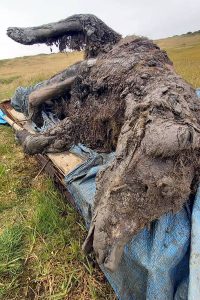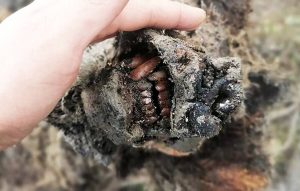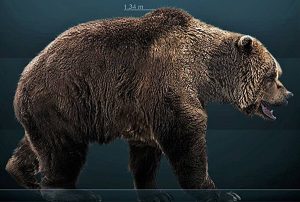:focal(640x427:641x428)/https://tf-cmsv2-smithsonianmag-media.s3.amazonaws.com/filer_public/50/1a/501abfd8-b561-4913-82fb-cf75acc81d20/6493c21e1c476c80c1b3ab63befd3ca5.jpeg)
Two and a half years ago, reindeer hunters discovered a perfectly preserved bear carcass, frozen for millennia in Siberian permafrost. Found on Bolshyoy Lyakhovsky, an Arctic island north of mainland Russia, the creature had its fur, skin, claws, teeth, body fat and internal organs all still intact, which is an extremely rare occurrence.

“This is the first and only find of its kind—a whole bear carcass with soft tissues,” paleontologist Lena Grigorieva said in a September 2020 statement announcing the discovery. “It is completely preserved, with all internal organs in place, including even its nose. Previously, only skulls and bones were found. This find is of great importance for the whole world.”
/https://tf-cmsv2-smithsonianmag-media.s3.amazonaws.com/filer_public/9a/ee/9aee8538-a7e7-45d0-b895-c99d0042264d/755613d21c8aa37f385ea270fbb51b1a.jpeg)
Scientists initially identified the animal—named the “Etherican bear” for the nearby Bolshoy Etherican River—as an extinct cave bear and said it had lived during the last Ice Age, probably between 22,000 and 39,500 years ago. But after conducting radiocarbon dating and genetic studies, they now say the animal is actually a brown bear, and it is 3,460 years old.

Though it’s not a window into the Ice Age after all, the bear carcass still provides scientists with an unprecedented opportunity: Researchers recently completed a necropsy, or animal autopsy, of the bear, reports Reuters’ Guy Faulconbridge. A team of scientists from the Lazarev Mammoth Museum Laboratory at North-Eastern Federal University (NEFU) carefully cut through layers of preserved skin, fat and tissue to examine the internal organs below. They conducted a variety of studies of its viruses, cells and microbes, and they sawed through the animal’s skull to extract its brain for further research.

From the necropsy, they were able to determine that the female bear was roughly two to three years old when it died. It stood 5.1 feet tall and weighed around 172 pounds. They don’t know exactly why it died; however, they did find evidence of spinal column injuries.
/https://tf-cmsv2-smithsonianmag-media.s3.amazonaws.com/filer_public/61/81/61817f86-ba67-4aad-8e15-7e2ea22f1090/cc882d473f5f94e6a0c834bf0d1c8265.jpeg)
Researchers also got a glimpse of what was likely the bear’s last meal, as the Siberian permafrost had even partially preserved its stomach contents. Inside, they found the remnants of unidentified plants and bird feathers.